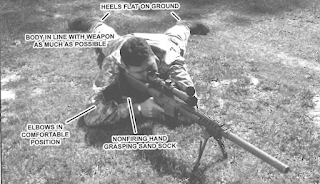The next step is to adjust your length of pull, if able, to ensure you have proper eye relief from your optic. Every manufacturer has the recommended distance from their optics, however the usual distance is three to three and a half inches from the objective lens, or rear of the sight.
As we settle in we have to align our cheek to our stock. I use grip tape, or a pad, to mark the position of my cheek on the buttstock. This allows me to place my head in the exact same position every time, and the pad gives my head slight elevation to properly align my sights.
Final step covers two topics: Sight alignment and sight picture. When you line up your rear sight with your front sight, ensure that your front sight post remains in the center of your rear sight aperture.
Sight picture is the blurring out the back ground to focus on the front sight post. You should clearly see your front sight post against a blurry target.
Iron sights should be a tool that everyone knows how to use. If you are shooting with optics, ensure that you have something else incase your primary optic goes down. Every time we would get a new optic, or we got our equipment serviced, we would spend extra time at the range to ensure that our back up iron sights where zeroed as well as our scoped optics.
Our marksmanship programs are designed with practical application in mind. What does that mean? Shooting fundamentals expand much further than the range. The biggest applications are hunting, home defense, discipline, attention to detail and confidence.
Stay tuned to our blog for the rest of the series. Head on over to Facebook and Instagram and give us a like and follow. Message us today to find out when our next event is and how to schedule your training in the West Valley of Phoenix
(The above photos are standard iron sights on many AR platforms.)




